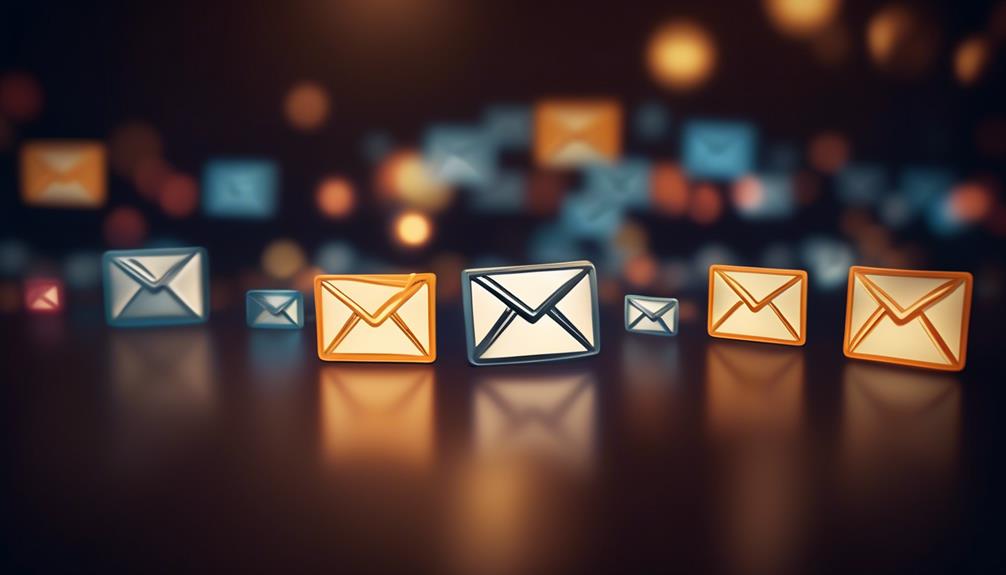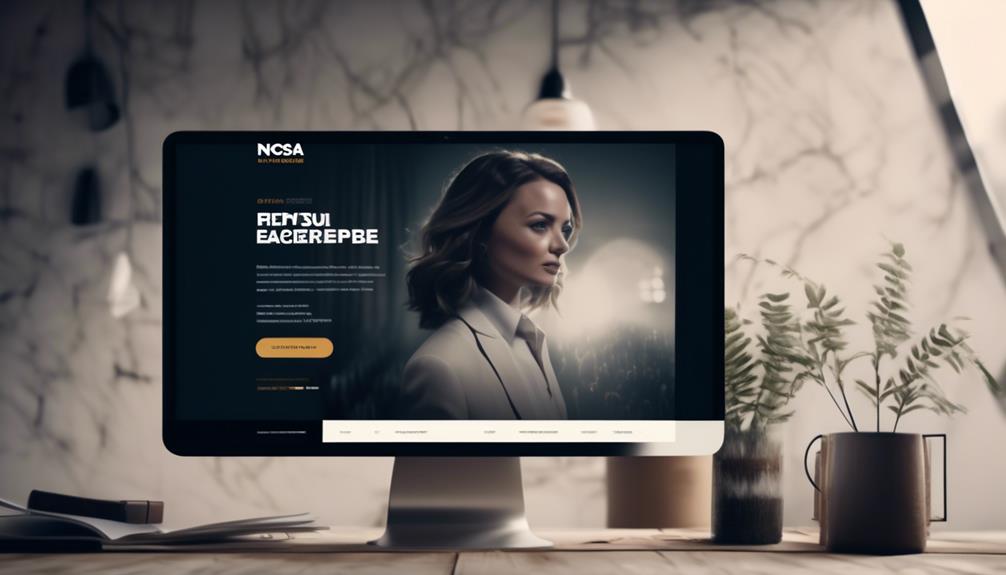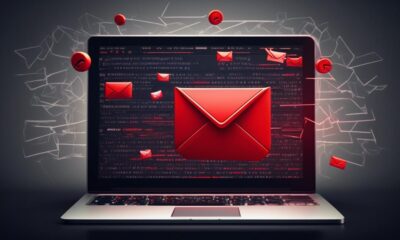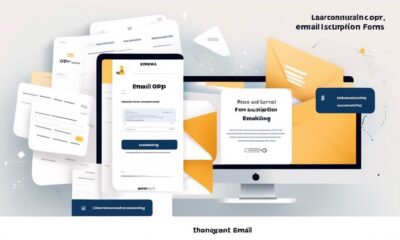Email Automation
What Goes Into Creating Successful Sales Email Sequences?
Yielding successful sales email sequences requires a perfect blend of art and science, but what are the key elements that make them work?

We’re all familiar with the idea that effective sales email campaigns blend both art and science, but what really makes them work?
It's not just about crafting compelling content; it's about understanding your audience and engaging them in a way that feels personalized and valuable.
So, how do we strike that balance and ensure our sales email sequences hit the mark?
Well, let's explore the key elements and strategies that contribute to creating successful sequences, and how they can ultimately drive results for your business.
Key Takeaways
- Tailoring email sequences to buyer personas enhances relevance and effectiveness.
- Incorporating social proof increases trust and credibility.
- Clear call-to-action motivates prospects to move forward.
- Utilizing automation software streamlines the process and provides insights.
Email Sequence Types
When crafting successful sales email sequences, it's essential to understand the various types of email sequences that can be employed to engage and convert leads. Understanding these types can help us create effective and targeted sequences that provide value to our leads.
The first type is the Nurturing Email Sequence, which aims to build a relationship with leads by providing free, valuable content. This helps in establishing trust and positioning our brand as a helpful resource.
The Engagement Email Sequence, on the other hand, focuses on encouraging interaction and response from leads. These emails often include questions or surveys to prompt engagement.
The Conversion Email Sequence plays a crucial role in moving leads further down the sales funnel by highlighting the value of our offerings and encouraging them to make a purchase.
Follow-Up Email Sequences are essential for maintaining contact with leads who've shown interest but not yet converted.
Lastly, Reminder Email Sequences can help in re-engaging leads who may have gone inactive.
Understanding and utilizing these types of email sequences can significantly help in converting leads into customers.
Key Elements of Compelling Sequences

As we shift our focus to the key elements of compelling sequences, it's crucial to understand how these elements contribute to the effectiveness of the various types of email sequences discussed. Crafting successful sales email sequences requires attention to certain key elements that drive engagement and conversions.
Here's what goes into creating compelling sequences:
- Tailoring to Buyer Personas: Understanding your audience's pain points, preferences, and behaviors is crucial. Customizing sequences to resonate with specific buyer personas and their needs enhances relevance and effectiveness.
- Optimizing Sales Cycle Length: Determining the ideal sequence length, number, and frequency of touches is essential. This ensures that your email sequence aligns with the typical length of your sales cycle, maximizing engagement without overwhelming prospects.
- Value-Driven Content: Varying the value proposition and information delivered in each touch is vital. Providing relevant and valuable content, incorporating social proof, and including a clear call to action in each email ensures that your sequence keeps prospects engaged and motivated to move forward.
Effective Cold Email Strategies
Crafting effective cold email strategies is essential for engaging prospects and driving conversions. When creating a cold email sequence, it's crucial to focus on personalization, clear call-to-actions, and segmentation.
Personalizing emails based on the recipient's interests and previous interactions increases relevance and engagement. Including a clear call-to-action in each email guides subscribers on the next steps, leading to higher conversion rates. Segmenting the audience based on behavior and preferences allows for targeted and tailored content, enhancing the overall effectiveness of the cold email sequence.
To write effective cold email sequences, it's essential to test and optimize based on data and feedback. Using email automation software can streamline this process and provide valuable insights. Planning the sequences in advance and creating a schedule ensures consistency and timely delivery. Additionally, studying case studies and best practices for email sequence examples can offer valuable insights and inspiration.
When sending cold emails, the subject line plays a crucial role in capturing the recipient's attention. Crafting compelling subject lines that are concise and relevant increases the open rates. Leveraging abandoned cart emails as part of the cold email sequence can also re-engage potential customers and drive conversions.
Building Successful Email Sequences

After mastering effective cold email strategies, we now shift our focus to building successful email sequences by defining our situation, goals, and buyer persona to tailor the sequence effectively.
To build successful email sequences, we must first define our situation, goals, and buyer persona. Understanding these elements allows us to create a tailored sequence that resonates with the recipients and compels them to take action.
Next, it's crucial to determine the right length, number, and frequency of touches based on our sales cycle. This ensures that we're not overwhelming the recipients with too many emails or leaving them disengaged with too few.
Lastly, personalization is key. Each touch within the sequence should be personalized with a unique value proposition and information that's relevant to the recipient. This approach makes the emails more engaging and increases the likelihood of prompting the prospect to take action.
How Can Automation Improve the Effectiveness of Sales Email Sequences?
Automation is the key to streamline and improve the effectiveness of sales email sequences. By using technology to automate sales email sequences, businesses can ensure timely follow-ups, personalized content, and accurate analytics tracking. This can lead to higher engagement and conversion rates, ultimately driving more sales.
Best Practices for Email Sequences
To maximize the effectiveness of email sequences, it's essential to adhere to best practices that enhance engagement and drive conversions.
When crafting email sequences, it's crucial to utilize automated emails for timely and personalized communication. Sales reps should leverage nurture emails to establish rapport and provide value to prospects based on their buyer persona.
Utilizing well-crafted email templates ensures consistency in messaging and branding across sequences. Including a clear and compelling Call to Action (CTA) in each email is vital for guiding prospects towards the desired conversion action.
Additionally, incorporating a Conversion Email that focuses on closing the sale or securing a prospect booking can significantly impact the sequence's success. It's essential to consider the timing and frequency of emails to avoid overwhelming recipients, making a Reminder Email a valuable addition to gently prompt action.
Frequently Asked Questions
How Do You Create an Effective Email Sequence?
We create effective email sequences by tailoring them to our specific goals and buyer persona. Our sequences provide value at each touchpoint, using varied value propositions and personalized messages across different communication channels.
We hook recipients with compelling subject lines and offer upfront value, while determining the right length, number, and frequency of touches for our sales cycle.
This approach ensures our email sequences are impactful and drive results.
How Do You Create a Good Sales Sequence?
To create a good sales sequence, we focus on defining the situation, goals, and buyer persona. We tailor the value proposition and information for each touch to keep it engaging.
Personalizing communications based on industry, role, and challenges makes it more relevant. We mix up the type of touches and go multi-channel for better engagement.
Providing value upfront before asking for their time keeps the language natural and recipient-focused.
What Is the Email Sequence Structure?
When structuring an email sequence, we ensure it effectively guides recipients towards our goals. It typically starts with a warm welcome email, followed by onboarding completion, lead nurturing, re-engagement, and event emails.
We strategically plan the subscribers' journey, automate the process for efficiency, and track email performance. This structured approach helps us engage and convert leads, fostering successful sales outcomes.
How Many Emails Should Be in a Sales Sequence?
We find that the optimal number of emails in a sales sequence varies based on the specific sales cycle and target audience. Our approach involves testing different sequence lengths to identify the sweet spot.
Conclusion
In conclusion, creating successful sales email sequences requires careful planning and personalization. By choosing the right sequence, customizing it to your buyer persona, and using a mix of channels, you can engage prospects and drive results.
Remember to vary your value proposition, provide upfront value, and keep the language natural. With these strategies, you'll be able to create email sequences that are so effective, they'll practically sell themselves!
Erik – Email, SEO, AI Expert Writer Erik is the strategist, the thinker, and the visionary. His role at Influenctor is pivotal in integrating SEO with AI-driven content strategies. With an extensive background in email marketing and a profound understanding of search engine algorithms, Erik develops innovative strategies that elevate our client’s online presence. His work ensures that our content is seen, felt, and remembered.
Email Template
Crafting an Effective Mentor Email Template
Open the door to mentorship success with our expert-approved email template – your key to unlocking valuable guidance and support.

We’ve all been there – staring at a blank screen, trying to compose the perfect email to a mentor. It can feel like quite the daunting task, can’t it?
The right words can make all the difference in catching a potential mentor’s attention and securing their guidance. But fear not, as we have some valuable insights and proven strategies to help you craft a compelling mentor email that will set you on the path to a fruitful mentorship.
So, are you ready to take your outreach to the next level and make a lasting impression on your prospective mentor?
Key Takeaways
- Personalization is key in mentor emails, showing a clear understanding of the potential mentor’s work and expertise.
- The tone of the first meeting is important, expressing a desire for mentorship and showcasing the value you bring as a mentee.
- Effective email templates for seeking mentorship emphasize genuine admiration for the mentor’s work, articulating career goals, and requesting a specific time for a discussion or meeting.
- When approaching potential mentors, thorough research, clear and concise requests, and highlighting the value you can offer are essential, while avoiding common mistakes such as a lack of research and self-centeredness.
Crafting the Perfect Mentor Email
Crafting the perfect mentor email requires personalized and thoughtful consideration of the potential mentor’s background and expertise. When reaching out to a potential mentor, it’s crucial to demonstrate a clear understanding of their work and how it aligns with your career goals. Utilizing a mentor email template can provide a structured approach, but personalizing the message to reflect genuine interest in the mentor’s work is essential. Researching the potential mentor beforehand allows for a tailored approach, highlighting specific connections between their expertise and your career aspirations.
In the mentorship program, the first meeting sets the tone for the relationship, making it crucial to craft an email that not only expresses your desire for mentorship but also showcases the value you bring to the table. Successful mentoring relationships are built on mutual respect and a willingness to learn. Therefore, when choosing someone to approach, it’s important to gauge your interest in their work and ensure that it aligns with your goals.
Effective Email Templates for Seeking Mentorship

Seeking mentorship through email can be a strategic and impactful way to connect with experienced professionals who can provide valuable guidance and support in your career journey. When crafting an email to seek mentorship, consider the following effective email templates:
- Express genuine admiration for the potential mentor’s work and achievements, showing that you’ve done your research and truly value their expertise.
- Clearly articulate your career goals and the specific areas in which you’re seeking guidance, demonstrating your commitment to personal and professional growth.
- Share your own experiences and challenges, allowing the potential mentor to understand your journey and the support you require.
- Emphasize how your core values align with those of the potential mentor, highlighting the potential for a mutually beneficial relationship.
- Request a specific time for a brief discussion or meeting to further explore the potential mentorship, showing that you respect their time and are serious about the opportunity.
Crafting an effective mentorship email can significantly increase your chances of capturing the attention of a potential mentor and initiating a meaningful connection that could positively impact your career path.
Tips for Approaching Potential Mentors
As we consider how to approach potential mentors, it’s essential to pivot from the effective email templates for seeking mentorship and focus on practical tips that can help us initiate meaningful connections with experienced professionals. When reaching out to potential mentors, it’s important to conduct thorough research to understand their background and expertise. This will demonstrate genuine interest and help tailor your approach effectively. Expressing a clear and concise request for a meeting is crucial; potential mentors are often busy individuals, so respecting their time is key. Highlight the value you can offer as a mentee, showcasing what sets you apart and how the mentorship can be mutually beneficial. Additionally, sharing your story and goals can help build a productive mentoring relationship. Here are some tips to consider when approaching potential mentors:
| Tips for Approaching Potential Mentors |
|---|
| Research potential mentors thoroughly |
| Clearly and concisely request a meeting |
| Highlight the value you can offer |
| Share your story and goals |
Approaching potential mentors with these tips in mind will help in initiating meaningful connections and creating a strong foundation for a successful mentoring relationship.
Common Mistakes to Avoid in Mentorship Requests

When approaching potential mentors, it’s important to avoid common mistakes that can hinder the effectiveness of mentorship requests. Here are some common mistakes to avoid:
- Not researching your potential mentor: It’s crucial to understand the background and expertise of the person you’re reaching out to.
- Focusing on self-centered gains: Mentorship is about mutual benefits and respect, so make sure your request reflects that.
- Sending a poorly structured email: A clear and concise email will effectively convey your message.
- Forgetting to express gratitude: Acknowledge the value the mentor can bring and how you can contribute as a mentee.
- Choosing the wrong communication method: Ensure that you reach out via email unless the mentor has explicitly stated a preference for a phone call.
Avoiding these mistakes will show potential mentors that you’re willing to go above and beyond to make the most out of the mentorship relationship.
Professional Email Samples for Seeking Mentorship
Crafting a compelling and well-structured email when seeking mentorship can significantly impact the success of your request and potential mentorship relationship. Professional email samples for seeking mentorship provide valuable guidance on how to approach potential mentors effectively. These templates offer structured and effective ways to express value as a mentee, align with a potential mentor’s core values, and request a meeting to discuss mentorship.
Whether you’re reaching out to someone you already know, seeking mentorship through a referral, or connecting on professional platforms like LinkedIn, these email structures and samples demonstrate thoughtfulness, research, and a clear request for mentorship. It’s crucial to express gratitude, show humility, and highlight the mutual benefits in the mentor-mentee relationship.
When using these professional email samples, it’s essential to convey your passion for learning, commitment to career development, and the opportunity to hop on a call to discuss how the potential mentor’s guidance can help you set and achieve your professional goals. These templates are designed to help you establish a mentoring relationship with individuals who are passionate about helping others succeed.
Frequently Asked Questions
How Do You Write a Mentor Email?
When writing a mentor email, it’s important to express admiration and respect. We can start by introducing ourselves and acknowledging their work. In the email, we can mention any previous conversations we have had with them and express appreciation for their expertise. Complimenting their work, if applicable, can also be a good idea. By expressing enjoyment of past conversations and admiration for their expertise, we can demonstrate sincerity and set the tone for a potentially valuable mentorship. Ultimately, the key is to convey genuine interest and respect in our communication with potential mentors.
How Do You Email a Potential Mentor Subject Line?
When reaching out to a potential mentor, we aim to craft a subject line that stands out in a crowded inbox. Using the mentor’s name or a mutual connection can increase the likelihood of your email being noticed.
In fact, subject lines that include a recipient’s name have been found to increase open rates by 20%.
It’s essential to convey enthusiasm and respect while keeping the subject line clear and concise.
How Do You Write a Message to a Mentor?
When writing a message to a mentor, we should start by expressing our admiration for their work and explaining why we’re reaching out.
We should be clear about what we hope to gain from the mentorship and how we believe the mentor’s expertise can help us.
It’s important to be respectful of the mentor’s time and to express gratitude for any assistance they can provide.
How Do You Write a Formal Letter to a Mentor?
When writing a formal letter to a mentor, it’s crucial to maintain a respectful and professional tone. Start with a polite salutation, use appropriate titles, and address the mentor with utmost respect.
Clearly state the purpose of the letter and provide relevant details. Be concise, yet thorough.
End with a gracious closing and your contact information.
Can the Mentor Email Template be Adapted for Reaching Out to Potential Candidates on Linkedin?
Yes, the mentor email template can easily be adapted for reaching out to potential candidates on LinkedIn. By tweaking the language and personalizing the message, the LinkedIn recruiter email template can be a powerful tool for engaging with qualified professionals on the platform.
Conclusion
In conclusion, reaching out to potential mentors can be a daunting task, but with the right approach and a well-crafted email, it can lead to invaluable guidance and support.
Remember, ‘don’t put all your eggs in one basket’ – it’s important to reach out to multiple potential mentors to increase your chances of finding the right match.
Good luck with your mentorship journey!
Natali – Editor in Chief (Strategy and Mastery, AI Expert) Natali, our Editor in Chief, is the driving force behind our content’s strategic direction. With a keen eye for detail and a deep understanding of market trends, Natali ensures that our content is top-notch and strategically aligned with our client’s goals. Her expertise in AI helps to seamlessly integrate advanced technology into our marketing strategies, pushing the boundaries of conventional marketing.
Email Template
Creating Professional NCSA Email Templates
Uncover the secrets of NCSA's Email Template and learn how it can transform your college recruitment efforts.

The saying “You never have a second chance to make a first impression” is particularly important when reaching out to college coaches. That’s why we strongly suggest checking out NCSA’s Email Template.
With its comprehensive guidance on crafting effective emails, this tool could be the key to standing out in a crowded inbox.
But there’s more to it than just the initial contact – the template also offers strategies for building lasting relationships with coaches.
Interested in finding out how to make a lasting impression and maximize your chances of getting noticed? Keep reading to discover the ins and outs of NCSA’s Email Template and how it could impact your athletic recruitment journey.
Key Takeaways
- Crafting an attention-grabbing subject line with specific details and standout information will increase the chances of your recruiting email getting noticed by coaches.
- Personalizing your email content by incorporating details about the coach’s team, recent achievements, and coaching philosophy shows that you’ve done your research and genuinely want to be part of their program.
- Utilizing the customization features of the template, such as tailoring the content, crafting a compelling subject line, and highlighting athletic and academic achievements, will align with the coach’s preferences and increase engagement.
- Maximizing engagement with follow-up strategies, such as personalized greetings, referencing previous interactions, utilizing the Message Center, including multimedia elements, and concluding with clear call-to-action, will help prompt specific next steps and feedback.
Crafting a Compelling Subject Line
Crafting a compelling subject line for your NCSA email can significantly impact your chances of grabbing a coach’s attention and standing out among the numerous emails they receive. When crafting subject lines for recruiting emails, it’s crucial to include specific details such as your name, graduation year, sport position or event, and location. This helps coaches quickly identify who you are and what you bring to the table. Adding standout details like your 40-yard dash time, GPA, or ACT score can further pique their interest. For example, a subject line could look like “John Smith | Class of 2023 | Wide Receiver | Chicago, IL | 40-Yard Dash: 4.5s | GPA: 3.8”. This subject line is concise yet packed with essential information that immediately showcases your athletic and academic prowess. It’s important to make every word count in the subject line to ensure it captures the coach’s attention and compels them to open your email. By following these guidelines, you can maximize the impact of your subject line and increase the likelihood of your recruiting email getting noticed amidst the coach’s busy inbox.
Personalizing Your Email Content

After capturing the coach’s attention with an attention-grabbing subject line that showcases your athletic and academic strengths, the next step is personalizing your email content to make a genuine connection and express your interest in their program. When personalizing your email, it’s crucial to go beyond simply addressing the coach by name. Incorporate specific details about their team, recent achievements, or coaching philosophy to show that you’ve done your homework and genuinely want to be part of their program.
Personalization Tips Examples Address the coach by name “Dear Coach Smith” Reference specific team accomplishments “I was impressed by your team’s recent championship” Highlight mutual connections “I noticed that we have a mutual connection in Coach Johnson” Express genuine interest in the program “I am excited about the opportunity to contribute to your program”
Using custom email templates can help maintain a personal touch while also ensuring consistency in your communication. It’s important to convey your passion for the sport and the program in a genuine and sincere manner. By making a personal connection and showing your dedication to the team, you can significantly increase the impact of your outreach efforts.
Utilizing the Template’s Customization Features
Utilizing the template’s customization features enhances the effectiveness of your email outreach by tailoring the content to align with the coach’s preferences and demonstrate your genuine interest in their program. Here are four ways to maximize the customization features:
- Craft a compelling subject line that grabs the coach’s attention and entices them to open your email.
- Personalize your introduction by addressing the coach by name and expressing genuine interest in their program.
- Utilize the customization features to highlight specific athletic and academic achievements that resonate with the coach’s preferences, showcasing your potential fit for their team.
- Leverage the action item feature to clearly outline your next steps and expectations, making it easy for the coach to understand your intentions and respond accordingly.
Maximizing Engagement With Follow-Up Strategies

When optimizing follow-up strategies, incorporating personalized greetings and referencing previous interactions builds a strong connection with the coach. By addressing the coach by name and mentioning specific details from past conversations, athletes can demonstrate genuine interest and engagement. This personalized approach showcases a commitment to the relationship and enhances the likelihood of a positive response.
Additionally, utilizing the Message Center to send an email allows for efficient communication and easy reference to previous correspondences. Furthermore, including multimedia elements, such as videos showcasing progress and improvement since the initial contact, can provide a compelling visual representation of the athlete’s development.
To maximize engagement, it’s crucial to conclude follow-up emails with a clear call-to-action, prompting the coach to take specific next steps or provide feedback on the athlete’s progress. Consistently following up at appropriate intervals demonstrates dedication and commitment to the recruitment process, reinforcing the athlete’s proactive and professional approach.
Tracking and Analyzing Email Performance
Tracking and analyzing email performance allows us to gain valuable insights into the effectiveness of our outreach efforts. By understanding the best time to send emails for optimal performance tracking, we can maximize the impact of our communications.
Using personalized tracking links, we can monitor recipient engagement with our emails, gaining valuable data on individual interactions. Analyzing open rates and click-through rates provides us with quantifiable metrics to gauge the effectiveness of our email campaigns. This allows us to identify trends and patterns in recipient behavior, informing our future email strategies.
By utilizing email performance metrics, we can refine and improve the content and strategies of our future emails, ensuring that our communications are continuously optimized for success. Implementing email tracking tools enables us to measure the success of our outreach efforts, providing us with concrete data to inform our decision-making process.
This comprehensive approach to tracking and analyzing email performance empowers us to make informed decisions and optimize our outreach efforts for maximum impact.
Frequently Asked Questions
Is NCSA Recruiting Legit?
Yes, NCSA recruiting is legit. It provides a centralized platform for athletes to connect with college coaches, offering efficient communication tools and the ability to contact coaches nationwide.
Athletes can easily manage and track recruiting correspondence using NCSA’s Message Center, which includes features for attaching documents and videos to showcase athletic abilities.
The platform streamlines the recruiting process, making it a legitimate and valuable resource for athletes pursuing college opportunities.
How Do You Write a Coaching Email?
When writing a coaching email, we focus on showcasing our athletic and academic achievements, expressing genuine interest in the program, and requesting an opportunity to connect.
We highlight our standout stats and include a specific action item, such as requesting a time for a phone call or an in-person meeting.
The subject line should include our name, graduation year, sport position, location, and a standout detail to grab the coach’s attention.
How Do You Announce a Commitment on Ncsa?
We announce a commitment on NCSA by logging into our account and navigating to the ‘My Commitments’ section. Here, we can input the details of our commitment, including the sport, college or university, and any additional information.
This information is then shared with our network of coaches and connections to inform them of our decision. This process ensures that our commitment is properly communicated and acknowledged within the NCSA platform.
How Do You Get Noticed on Ncsa?
To get noticed on NCSA, we need a standout subject line and a personalized introduction. Highlighting our athletic and academic achievements will make us stand out.
We should also provide a clear call to action for the coach to respond or take the next step. Utilizing NCSA’s Message Center will help us efficiently communicate with coaches.
Standing out and being proactive are key to getting noticed on NCSA.
Can the NCSA Email Template be Adapted for Mentoring Purposes?
Yes, the NCSA email template for mentors can be easily adapted for mentoring purposes. By customizing the content to reflect mentoring goals and objectives, the template can effectively facilitate communication between mentors and mentees, streamlining the mentoring process and ensuring clarity and consistency in messaging.
Conclusion
In conclusion, utilizing NCSA’s Email Template and Message Center can greatly enhance your communication with college coaches and improve your athletic recruitment prospects.
Remember, ‘Rome wasn’t built in a day,’ so be patient and persistent in your efforts to connect with coaches and showcase your talents.
By following the template’s guidelines and utilizing its customization features, you can effectively track and analyze your email performance to maximize engagement and ultimately achieve your recruitment goals.
Natali – Editor in Chief (Strategy and Mastery, AI Expert) Natali, our Editor in Chief, is the driving force behind our content’s strategic direction. With a keen eye for detail and a deep understanding of market trends, Natali ensures that our content is top-notch and strategically aligned with our client’s goals. Her expertise in AI helps to seamlessly integrate advanced technology into our marketing strategies, pushing the boundaries of conventional marketing.
How to Write Email
Crafting a Polished PTO Request Email
Need guidance on crafting a professional PTO request email? Learn key tips and essential components to ensure your request stands out.

As professionals in our specific fields, we all understand the importance of striking a balance between our work responsibilities and personal lives.
However, when it comes to requesting PTO, it can be a delicate task to navigate. Finding the right balance between being concise and providing all necessary information can be challenging, but it’s essential for a successful request.
In this discussion, we’ll explore the key components of crafting a well-written PTO request email, ensuring that your request is clear, professional, and respectful of your supervisor’s time.
Key Takeaways
- PTO plays a crucial role in maintaining work-life balance and employee well-being.
- Open communication with managers is essential for effective leave planning.
- Crafting a well-written PTO request email involves using a clear subject line, stating the reason for the request, expressing gratitude, and offering assistance during absence.
- PTO management tools simplify the process of requesting and managing leave, reducing scheduling conflicts and ensuring adequate staffing.
Understanding PTO and Its Importance
Understanding the significance of PTO in maintaining a healthy work-life balance is crucial for both employees and the overall company culture. PTO, or paid time off, plays a vital role in ensuring that employees have the opportunity to rest, recharge, and tend to personal matters without compromising their financial security.
It’s important for employees to have a clear understanding of PTO policies, which are typically outlined in the employee handbook or company policy documents. Open communication with managers or supervisors regarding PTO usage is essential for planning leave requests effectively.
By recognizing the importance of work-life balance, employees can proactively manage their time off, providing ample notice for planned absences and ensuring minimal disruption to workflow. Furthermore, a company culture that values and encourages the use of PTO fosters employee well-being, satisfaction, and productivity.
It’s crucial to acknowledge the correlation between taking time off and preventing burnout, as well as the positive impact it has on overall job performance and satisfaction.
Crafting a Clear and Persuasive Email

Crafting a clear and persuasive email to request PTO requires careful attention to detail and a thoughtful approach that effectively communicates the need for time off. Start by crafting a clear and concise subject line that summarizes the purpose of the email.
When writing the body of the email, clearly state the reason for the PTO request, including specific dates and the type of leave being requested. It’s important to provide a brief explanation of the importance of the requested time off, emphasizing the positive impact on work-life balance and overall well-being.
Express gratitude and maintain a professional and respectful tone throughout the email.
End the email with a willingness to discuss the request further and offer assistance in ensuring a smooth transition during the absence. This approach helps to ensure that your email is persuasive and effectively conveys the need for time off to your manager or team.
Tips for Writing a Professional Email
When requesting PTO, it’s essential to maintain a professional tone and adhere to specific guidelines for crafting a clear and persuasive email. Here are some tips for writing a professional email to request vacation time off.
Firstly, ensure the subject line clearly indicates the purpose of the email, such as ‘Request for PTO: [Your Name].’ This helps the recipient understand the email’s content at a glance.
Next, address the recipient with a formal salutation, using ‘Dear [Manager’s Name]’ or ‘Hello [Manager’s Name]’ to maintain professionalism.
In the body of the email, clearly state the purpose of the email, including the dates for which you’re requesting PTO and any pertinent details related to your request. Be sure to adhere to company policy and provide ample notice if required.
Use polite and respectful language throughout the email to convey your request professionally.
Finally, close the email with a professional sign-off, such as ‘Sincerely’ or ‘Best regards,’ and include your contact information for further communication if necessary.
Examples of Effective Time Off Request Emails

We are writing to request time off from [specific start date] to [specific end date] for personal reasons. According to our company’s vacation policy, we understand the importance of providing advance notice and making a formal request for vacation time.
To ensure a successful request, it’s crucial to write a vacation request email with a clear subject line and a professional tone in the body of the email. When composing the email, it’s essential to clearly state the reason for your vacation and adhere to the specific dates required. Additionally, it’s important to adhere to the company’s vacation policy and any specific procedures outlined for requesting time off.
- State the specific dates for the requested time off.
- Clearly outline the reason for the time off.
- Express gratitude for the consideration of the request.
Simplifying Time off Requests With PTO Tools
By utilizing PTO management tools such as Flamingo, companies can streamline the process of requesting and managing leave, allowing employees to submit their requests directly from Slack and enabling managers or supervisors to promptly approve or deny them while maintaining an updated leave calendar. This simplifies time off requests, creates a paper trail, and ensures that the vacation policy is adhered to. PTO tools like Flamingo also make it easier for employees to let their manager know about their vacation plans, reducing the likelihood of scheduling conflicts and ensuring that the team is adequately staffed at all times. The use of these tools helps in avoiding the back-and-forth of vacation request emails and sample vacation request emails, making the entire process efficient and transparent. Here’s an example of a simplified time off request process using PTO tools:
Benefits of PTO Tools Streamlined process Direct Slack submission Prompt approval/denial
Frequently Asked Questions
How Do You Write a Formal Email Request?
We write a formal email request with a clear subject line, specified dates, and a friendly tone.
Understanding the benefits of PTO and its impact on work-life balance is crucial.
Providing a status update upon return and arranging coverage during absence are essential.
Familiarizing ourselves with company policies, considering paid versus unpaid time off, and asking for time off at the right time are necessary.
We express willingness to address concerns, be polite and appreciative, and provide assurance that work will be covered.
How Do You Write a Day off Request Email?
When writing a day off request email, we keep it professional, brief, and polite. We express gratitude for the opportunity and clearly state the dates and reason for the request.
We ensure the recipient understands that we’ve considered any potential impact on work and have a plan to address it. It’s crucial to follow any specific company procedures for requesting time off and to be open to discussing any adjustments if needed.
How Do You Politely Ask for Leave in an Email?
When politely asking for leave in an email, we ensure to be concise, providing specific dates and reasoning. We maintain a professional tone and express gratitude for considering our request.
Including a subject line that clearly states the purpose aids in effective communication. It’s important to highlight our commitment to completing pending tasks and offering a plan for coverage during our absence.
Clear communication helps in getting our leave approved.
How Do I Request a PTO Email Example?
Sure, requesting a PTO email example is a common need. We can provide a clear and professional sample that you can use as a template.
It’s essential to tailor it to your specific situation and company culture. We’ll include a polite tone and necessary details for an effective request.
This example will serve as a helpful guide for crafting your own PTO request email.
Conclusion
In conclusion, requesting time off is an essential part of maintaining a healthy work-life balance. By following the tips and examples provided, you can craft a persuasive and professional PTO request email that will help you secure the time off you need.
Remember to be proactive in preparing for your absence and to show appreciation for your supervisor’s understanding. With the right approach, you can make the process of requesting time off as smooth as butter.
Erik – Email, SEO, AI Expert Writer Erik is the strategist, the thinker, and the visionary. His role at Influenctor is pivotal in integrating SEO with AI-driven content strategies. With an extensive background in email marketing and a profound understanding of search engine algorithms, Erik develops innovative strategies that elevate our client’s online presence. His work ensures that our content is seen, felt, and remembered.
-

 Email Marketing Tools and Techniques1 month ago
Email Marketing Tools and Techniques1 month agoHow to Export Mailchimp Contacts
-

 How to Write Email2 months ago
How to Write Email2 months agoHow to Write Negative Feedback Email: Sample Guide
-

 Email Automation3 months ago
Email Automation3 months agoAutomated Email Marketing 101: A Beginner's Tutorial
-

 Marketing Strategy3 weeks ago
Marketing Strategy3 weeks agoHow to Make an Offer So Good That Customers Can’t Resist!
-

 Email Warmup3 weeks ago
Email Warmup3 weeks agoWarm Follow-Up Email
-

 GDPR Email Marketing4 weeks ago
GDPR Email Marketing4 weeks agoGDPR Email Marketing: Consent Examples Guide
-

 Email Design Hub1 month ago
Email Design Hub1 month ago3 Essential Tools for Email Marketing Design Success
-

 Email Marketing1 day ago
Email Marketing1 day agoWhat Is Email Marketing Advantages and Disadvantages



















